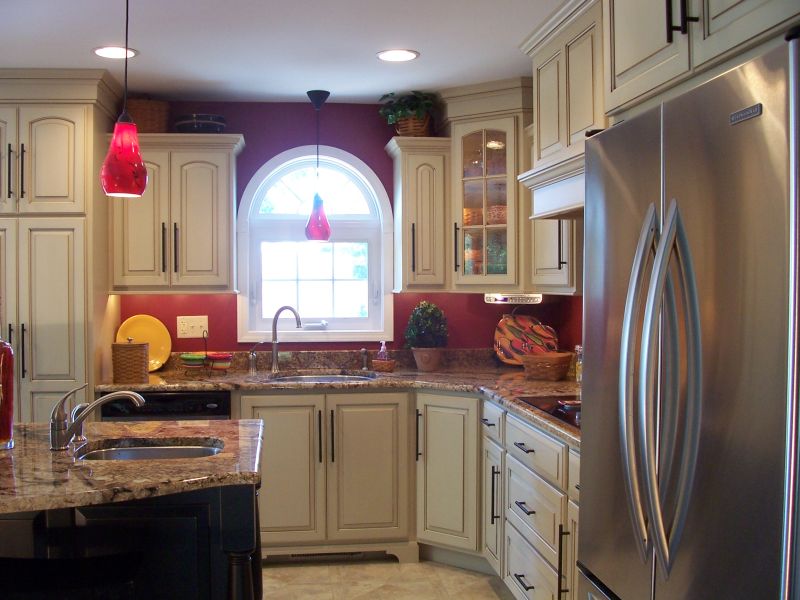Mounting Plates for Cabinet Hinges
A discussion of mounting hardware and hinge positioning for Blum hinges. June 17, 2013
Question
I'm trying to determine the type of mounting plate for Blum hinges. I'm using the Excel spreadsheet they provide. I put in all of the required measurements for the spreadsheet, but the section for choosing mounting plate types does not provide much (any?) guidance. I just want to use wood screws for a full overlay 3/4" thick door using panel construction. I'd really appreciate it if somebody could give me an idea on how to make this choice:
For example,
1 piece wing
2 piece wing
cam
cam in-line
etc.
It looks like part of the decision is stamped or die-cast. Is one better/stronger than the other? The cam in-line looks the nicest.
Forum Responses
(Cabinetmaking Forum)
From contributor D:
I use die cast for everything. I just think the stamped look cheap. The only thing I have ever used inline for was to solve a clearance issue. Plus inline only fixes with two screws and I like to use three screws. 175H7100 is, I believe, what you want.
From the original questioner:
Thanks. That was my first guess (lucky).
For the hinge, I chose: Blum 75T1590B CLIP Top Full Overlay INSERTA Cabinet Door Hinge with 107-Degree Opening Angle and Self Close Function
I don't need to go past 90 degrees and I want to screw in without any special tools. How does that sound?
From contributor D:
That's fine if your bulkheads are only 5/8 thick. You cannot get a full 3/4" overlay with that hinge.
From the original questioner:
I've got 3/4" sides and I'm going for a 3/32" reveal. I want to run trim up against the sides that is flush with the 3/4" thick doors. If that's not right, would you make a suggestion?
From contributor C:
We work in millimeters at our shop. The hinge you speak of can be made to overlay a 19mm cabinet side by 17mm, leaving a 2mm reveal. This is accomplished with hinge cup drilled 6mm from the door edge. The mounting plate you would use is the 0mm plate.
My experience with the die cast plates is that they are brittle. We have had many callbacks over the years to replace this type of plate. My preference is the stamped steel plate. Perhaps they have engineered the cast plates better since our experience with them. We order our plates with the pre-mounted euro screws and love them. The stamped steel is simpler, more reliable and best of all, costs less.
If you want to use wood screws to mount the plate, the stamped plate is B173H710. If you want to use the cast plates, the number is B175H710. These numbers are from my HDL Catalog.
From the original questioner:
Thanks. I have 18mm sides. So if I want to open up the reveal a little bit, it sounds like I can make that adjustment by changing where I locate the hinge cup. So, say I wanted a 2.5 mm reveal, I would locate the hinge cup at 6.5 mm. Correct? Just checking...
From contributor H:
We use the stamped steel Blum plate with the cam adjustment and Expando dowels. These are exponentially stronger than any plate you can install with a screw. The nylon dowel bites into whatever material you are using - MDF, melamine, or plywood - and will never come loose. We use the same hinges - the full overlay Inserta with integrated soft close feature. Works flawlessly and the amount of overlay can be controlled by the 35mm bore setback as others have said.
From contributor C:
You are on the right track! The hinge chart says the distance bored from the edge can range from 3mm to 6mm. So the 6.5 DBE is 1/2 a millimeter. More than they recommend. If you drill a test piece, you can check what happens when you start to exceed the specs. I think the back edge of the door starts to bind upon opening.
From contributor B:
These hinges have side-to-side adjustment. You'll be fine maintaining the gap you require. With a 6mm tab, they'll just cover a 19mm side panel. Don't exceed 6mm as the inside edge of the door as it will hit the panel as it opens.
It's worth taking a few minutes to read and understand Blum's thorough documentation. Once you get beyond the initial intimidation of being confronted with graphs and charts, it'll help a lot. Yeah, stamped plates.
From contributor J:
Sounds like the others have you on the right track. Only thing I'll add is to seriously consider using Euro screws on plates whenever possible. If you're still using regular #6 x 5/8" screws, those are pretty much the least reliable setup possible. They have a tendency to come loose and will require tightening at some point down the road. The Euro screws require very little additional work and are well worth it.
From contributor L:
Good advice except stay away from the die cast plates. As said, they are brittle and break easily. We use the Inserta 120 degree hinges (less likely to be damaged by over stressing by being pushed past the stop) but for more demanding applications we use Salice institutional hinges (stronger hinge, no stop issues). Try to not use the 165 degree hinges. They have bad sag problems over time. Plates are best mounted with either the nylon expanding dowels or Euro screws, not the #7 screws. Hinge overlay is controlled by either or both the rise of the plate or the crank of the hinge. All the hinges will sag some with time. Allowing a bit of extra margin will delay when the doors hit each other. Homeowners will not adjust them. Don't use up all the adjustment to start with. Leave some for later adjustment.
